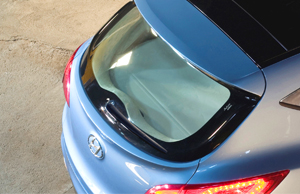
PARIS – A Chinese or Indian auto maker could be the first to go for plastic car windows in a big way, says an executive at Sabic Innovative Plastics.
“In China and India, they are not tied to an existing infrastructure,” says Venkatakrish Umamaheswaran, director-automotive products and marketing. “Because they are developing a project with a clean piece of paper, it provides a more fertile territory.
“A lot of industry technology that requires a new way of thinking is well-received” in those emerging markets, he adds.
The technology in question is polycarbonate glazing, and Sabic is investing heavily to get ready for a breakthrough it hopes will arrive soon thanks to the pressure to improve fuel economy.
Polycarbonate windows weigh half as much as glass, and because they are made with injection molding they can come in shapes that can’t be imagined with glass.
However, the material is more expensive. To get auto makers to convert, Sabic and its main material competitor, Bayer MaterialScience, have to sell the idea of integrating other parts into the plastic mold that makes the window.
For example, says Umamaheswaran, “on a liftgate, a lot of features can be integrated, and if the manufacturer is short of room in the factory, it can be delivered as a module.”
A modular liftgate could include the window, cladding for the D-pillar, a roof spoiler, the high-mounted rear brake light, a rear wiper foot, handles and logos. When all those processing costs are included, he says, polycarbonate is competitive with glass and metal.

What is not in question is the weight savings. Bugatti developed a targa top for its Veyron 16:4 Grand Sport roadster in both glass and polycarbonate from Bayer, and the plastic version chosen had a weight savings of 13.0 lbs. (5.9 kg).
Sabic says Hyundai’s HED-4 concept car used polycarbonate for its backlite, sidelites and roof, cutting weight by 38.1 lbs. (17.3 kg).
Plastics Europe, an industry organization based in Belgium, says 31-49 lbs. (14-22 kg) of carbon-dioxide emissions are saved for each 2.2 lbs. (1 kg) of polycarbonate used on cars over their lifetime, and adds that “use of lightweight polycarbonate in panorama roof applications lowers the center of gravity and, therefore, increases the stability of the vehicle.”
Sabic this year added capacity for polycarbonate in a Saudi Arabian plant, and in May it signed a memorandum of understanding with its Chinese joint-venture partner, China Petroleum & Chemical, to build a new facility in China with a polycarbonate capacity of 260,000 tons (236,000 t) a year beginning in 2015.
The facility will help answer demand for DVD and CD disks, as well as automotive applications.
Sabic also has invested in its U.S. Glazing Technology Development Center in Wixom, MI, to rebuild a pilot production line. That project involves Exatec, the subsidiary for developing automotive polycarbonate, and a partnership with the Japanese tool maker ULVAC.
The partners are creating tools enabling Tier 1 suppliers to manufacturer high-volume polycarbonate glazing with a plasma finish that puts a protective layer of silicon on the softer plastic.
Exatec was once a JV between GE Plastics and Bayer MaterialScience, the two main polycarbonate suppliers. GE Plastics bought out Bayer, and Saudi Basic Industries Corp. – Sabic – bought GE Plastics.
“We are trying to lead this,” says Umamaheswaran. “For 10 years, we have been investing in glazing technology. We believe now is the time.”
Polycarbonate has become standard for headlamp covers, and auto makers experimented a lot with the material in the early half of the 2000s. But few projects have been publicized in the past several years.
The Smart Fourtwo was the first to use polycarbonate windows, with fixed rear sidelites starting in 1998. Supplier Freeglass has made about 4 million plastic windows for Smart, Mercedes-Benz, the European Honda Civic and the SEAT Leon.
Sabic is confident that polycarbonate will find a place on high-volume projects that need to improve fuel economy. The company has a new selling point: the insulation factor of plastic, when treated with resins that absorb near infrared light waves.
Matteo Terragni, Sabic’s segment manager for automotive glazing in Europe, says if plastic glazing is used on a panoramic roof and backlite of a moving car instead of glass, it will reduce the need for heating in winter and cooling in summer by 9° F (5º C) in extreme climates.
“There is a very big interest by OEMs,” he says in an interview. “The reduced demands on climate control have the same amount of benefit as the weight savings (on fuel economy). We now show a double advantage.”
The light weight and insulation factors also are critical to electric vehicles, allowing them to either increase range or use smaller, less costly batteries, but Terragni admits that getting developers to use “a highly engineered material with a look and feel like glass is a paradigm shift.”
Still, says Umamaheswaran, “we are seeing projects that are larger than those we have seen in the past.” While no high-volume project is now on Sabic’s books, he expects something to arrive in 2014 or 2015.




